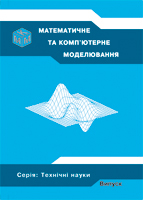Расчет числа образующих полиномов для регистров сдвига с нелинейной обратной связью с нелинейностью произвольного по-рядка
DOI:
https://doi.org/10.32626/2308-5916.2017-15.179-185Анотація
Рассматривается один из важных элементов генератора поточных шифров — регистры сдвига с нелинейной обратной связью (РСНОС). Рассматриваются РСНОС с нелинейностью произвольного порядка. Изучается число различных образующих полиномов, на основе которых можно построить РСНОС. В качестве результата приводятся расчетные выражения для определения числа РСНОС как произвольного порядка, так и для РСНОС максимального порядка при заданном размере регистраПосилання
Горбенко Ю. І. Побудування та аналіз систем, протоколів і засобів криптографічного захисту інформації. Частина 1: Методи побудування та ана-лізу, стандартизація та застосування криптографічних систем: За заг. ред. д.т.н., професора І.Д. Горбенка. Харків: Видавництво «Форт», 2015. 960 с.
An NLFSR-Based Stream Cipher. Berndt M. Gammel, Rainer G¨ottfert and Oliver Kniffler Infineon Technologies AG, Munich, Germany. Режим доступа: https://www.researchgate.net/ publication/224647778
Martin Hell, Thomas Johansson, Willi Meier, Grain — A Stream Cipher for Constrained Environments, Estream submissionmany. Режим доступа: http://www.ecrypt.eu.org/stream/p3ciphers/ grain/Grain_p3.pdf
Golomb S. Shift Register Sequences. Aegean Park Press. 1982.
Gammel B., Gottfert R., Kniffler O. Achterbahn-128/80: Design and analysis. in SASC’2007: Workshop Record of The State of the Art of Stream Ciphers. 2007. P. 152–165.
Chen K., Henricken M., Millan W., Fuller J., Simpson L., Dawson E., Lee H., Moon S. (2005) Dragon: A fast word based stream cipher. in eSTREM, ECRYPT Stream Cipher Project. Report 2005/006.
Hell M., Johansson T., Meier W. (2005). Grain — a stream cipher for constrained environments. Режим доступа: citeseer.ist.psu.edu/732342.html.
Canniere C., Preneel B. TRIVIUM specifications. Режим доступа: cite-seer.ist.psu.edu/734144.html. 2006.
Gittins B., Landman H., O’Neil S., Kelson R. A presentation on VEST hardware performance, chip area measurements, power consumption estimates and benchmarking in relation to the aes, sha-256 and sha-512. Cryptology ePrint Archive, Report 2005/415. Режим доступа: http://eprint.iacr.org/. 2005.
Canteaut A. Open problems related to algebraic attacks on stream ciphers. in WCC. 2005. P. 120–134.
Zeng K., Yang C., Wei D., and Rao T.R.N. «Pseudo-random bit generators in stream-cipher cryptography». Computer. 1991.
David R. Random Testing of Digital Circuits. New York: Marcel Dekker. 1998.
Massey J. L. «Shift-register synthesis and BCH decoding». IEEE Transactions on Information Theory, Vol. 15. 1969. P. 122–127.
Dubrova E., Teslenko M., and Tenhunen H. «On analysis and synthesis of (n,k)-non-linear feedback shift registers», in Design and Test in Europe. 2008. P. 133–137.
Коробейников А. Г., Гатчин Ю. А. Математические основы криптологии. Учебное пособие. Санкт-Петербург. 2004. Режим доступа: http://books.ifmo.ru/file/pdf/56.pdf.
Полуяненко Н. А., Потий А. В. Сравнение объема ансамбля М-РСЛОС и М-РСНОС, скорости генерации на их основе, для GF(2) и в расширениях поля GF(22). Радиотехника. Всеукраинский межведомственный научно-технический сборник. 2016. № 186/216. С. 153–160.
##submission.downloads##
Опубліковано
Номер
Розділ
Ліцензія
Authors who publish with this journal agree to the following terms:- Authors retain copyright and grant the journal right of first publication with the work simultaneously licensed under a Creative Commons Attribution License that allows others to share the work with an acknowledgement of the work's authorship and initial publication in this journal.
- Authors are able to enter into separate, additional contractual arrangements for the non-exclusive distribution of the journal's published version of the work (e.g., post it to an institutional repository or publish it in a book), with an acknowledgement of its initial publication in this journal.
- Authors are permitted and encouraged to post their work online (e.g., in institutional repositories or on their website) prior to and during the submission process, as it can lead to productive exchanges, as well as earlier and greater citation of published work (See The Effect of Open Access).

